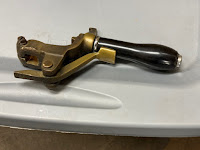Frank writes...
I was out at the museum on Sunday, but unfortunately failed to take photos of what I was doing. We did get some spare parts put away and took that battery box cover from Shaker Heights 63 over to the paint store to get the vermilion/orange color matched - many thanks to Good Nick for his help with that! The shop was busy with various things happening, including a switch move that saw CRT 1268 moved back out of Barn 4 just a week after it arrived. You'll need to ask Tim what's happening with that. I had hoped to put a coat of cream paint on the 18's windows, but realized the cream paint had been left at home - oops. That will wait until next time.
Anyway, we have here a mystery: this handle (brake handle?) showed up in a collection of items and we can't figure out what it's from. Anyone know?



5 comments:
At first, I wanted to say it was a method of diabolical torture (We have ways of making you talk!) but I suspect it's a brake handle with a thumb-operated sanding valve.
Note that the lever lifts up something that's directly above the stem of the valve. That's part of the reason we discounted it being for sanding, unless it's some unusual arrangement we shop guys hadn't seen.
R. W. Schauer
Yes. But I don't see why that wouldn't work. You would have to raise the lever in order to install or remove the handle, so that it engages properly with whatever is above the stem. Whatever it was designed to do, it certainly is unusual.
It looks to me like you would pivot the lever away from the grip, and then have just enough clearance to lift the handle up and away from the valve stem. That said, you would first need to loosen the handle from the stem with a screwdriver or wrench, which makes me think this handle wasn't meant to be removed from the valve in regular use.
I think that lever is indeed for a sander; I also think this handle may be from some property outside the US.
Lisbon had break valves with integral sanders. Maybe Oporto as well? The style of construction says 1930s to me.
Post a Comment